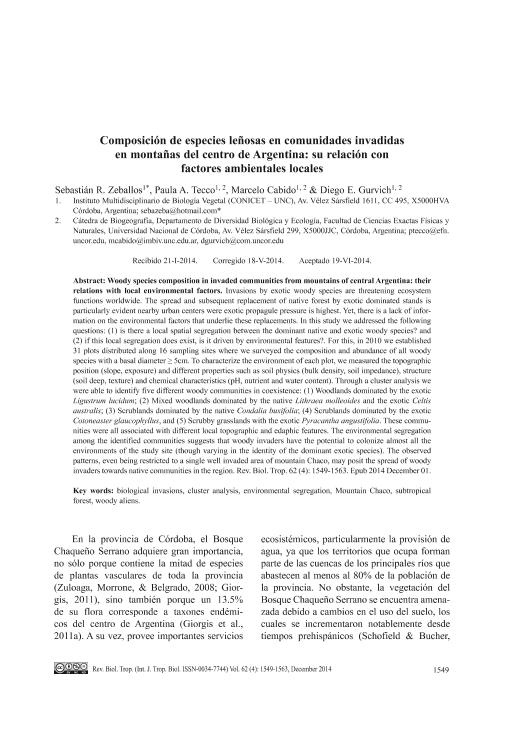Mostrar el registro sencillo del ítem
dc.contributor.author
Zeballos, Sebastián Rodolfo

dc.contributor.author
Tecco, Paula Andrea

dc.contributor.author
Cabido, Marcelo Ruben

dc.contributor.author
Gurvich, Diego Ezequiel

dc.date.available
2017-11-01T15:19:35Z
dc.date.issued
2014-12
dc.identifier.citation
Zeballos, Sebastián Rodolfo; Tecco, Paula Andrea; Cabido, Marcelo Ruben; Gurvich, Diego Ezequiel; Composición de especies leñosas en comunidades invadidas en montañas del centro de Argentina: su relación con factores ambientales locales; Universidad de Costa Rica; Revista de Biología Tropical; 62; 4; 12-2014; 1549-1563
dc.identifier.uri
http://hdl.handle.net/11336/27311
dc.description.abstract
Invasions by exotic woody species are threatening ecosystem functions worldwide. The spread and subsequent replacement of native forest by exotic dominated stands is particularly evident nearby urban centers were exotic propagule pressure is highest. Yet, there is a lack of information on the environmental factors that underlie these replacements. In this study we addressed the following questions: (1) is there a local spatial segregation between the dominant native and exotic woody species? and (2) if this local segregation does exist, is it driven by environmental features?. For this, in 2010 we established 31 plots distributed along 16 sampling sites where we surveyed the composition and abundance of all woody species with a basal diameter ≥ 5cm. To characterize the environment of each plot, we measured the topographic position (slope, exposure) and different properties such as soil physics (bulk density, soil impedance), structure (soil deep, texture) and chemical characteristics (pH, nutrient and water content). Through a cluster analysis we were able to identify five different woody communities in coexistence: (1) Woodlands dominated by the exotic Ligustrum lucidum; (2) Mixed woodlands dominated by the native Lithraea molleoides and the exotic Celtis australis; (3) Scrublands dominated by the native Condalia buxifolia; (4) Scrublands dominated by the exotic Cotoneaster glaucophyllus, and (5) Scrubby grasslands with the exotic Pyracantha angustifolia. These communities were all associated with different local topographic and edaphic features. The environmental segregation among the identified communities suggests that woody invaders have the potential to colonize almost all the environments of the study site (though varying in the identity of the dominant exotic species). The observed patterns, even being restricted to a single well invaded area of mountain Chaco, may posit the spread of woody invaders towards native communities in the region.
dc.format
application/pdf
dc.language.iso
spa
dc.publisher
Universidad de Costa Rica

dc.rights
info:eu-repo/semantics/openAccess
dc.rights.uri
https://creativecommons.org/licenses/by-nc-sa/2.5/ar/
dc.subject
Biological Invasions
dc.subject
Cluster Analysis
dc.subject
Environmental Segregations
dc.subject
Woody Aliens
dc.subject.classification
Bioquímica y Biología Molecular

dc.subject.classification
Ciencias Biológicas

dc.subject.classification
CIENCIAS NATURALES Y EXACTAS

dc.title
Composición de especies leñosas en comunidades invadidas en montañas del centro de Argentina: su relación con factores ambientales locales
dc.title
Woody species composition in invaded communities from mountains of central Argentina: their relations with local environmental factors
dc.type
info:eu-repo/semantics/article
dc.type
info:ar-repo/semantics/artículo
dc.type
info:eu-repo/semantics/publishedVersion
dc.date.updated
2017-10-10T18:32:46Z
dc.identifier.eissn
0034-7744
dc.journal.volume
62
dc.journal.number
4
dc.journal.pagination
1549-1563
dc.journal.pais
Costa Rica

dc.journal.ciudad
Turrialba
dc.description.fil
Fil: Zeballos, Sebastián Rodolfo. Consejo Nacional de Investigaciones Científicas y Técnicas. Centro Científico Tecnológico Conicet - Córdoba. Instituto Multidisciplinario de Biología Vegetal. Universidad Nacional de Córdoba. Facultad de Ciencias Exactas Físicas y Naturales. Instituto Multidisciplinario de Biología Vegetal; Argentina
dc.description.fil
Fil: Tecco, Paula Andrea. Consejo Nacional de Investigaciones Científicas y Técnicas. Centro Científico Tecnológico Conicet - Córdoba. Instituto Multidisciplinario de Biología Vegetal. Universidad Nacional de Córdoba. Facultad de Ciencias Exactas Físicas y Naturales. Instituto Multidisciplinario de Biología Vegetal; Argentina
dc.description.fil
Fil: Cabido, Marcelo Ruben. Consejo Nacional de Investigaciones Científicas y Técnicas. Centro Científico Tecnológico Conicet - Córdoba. Instituto Multidisciplinario de Biología Vegetal. Universidad Nacional de Córdoba. Facultad de Ciencias Exactas Físicas y Naturales. Instituto Multidisciplinario de Biología Vegetal; Argentina
dc.description.fil
Fil: Gurvich, Diego Ezequiel. Consejo Nacional de Investigaciones Científicas y Técnicas. Centro Científico Tecnológico Conicet - Córdoba. Instituto Multidisciplinario de Biología Vegetal. Universidad Nacional de Córdoba. Facultad de Ciencias Exactas Físicas y Naturales. Instituto Multidisciplinario de Biología Vegetal; Argentina
dc.journal.title
Revista de Biología Tropical

dc.relation.alternativeid
info:eu-repo/semantics/altIdentifier/url/http://revistas.ucr.ac.cr/index.php/rbt/article/view/12995
Archivos asociados
